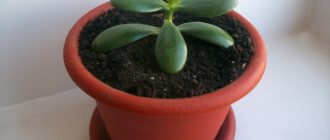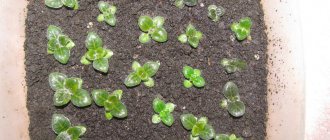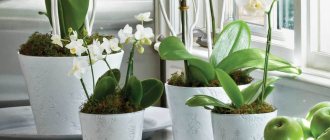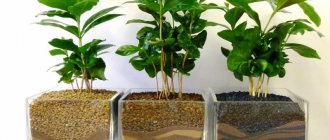What soil is needed for an Arabica coffee tree? Conditions and care
How to care for a coffee tree.
Like any southern tree, coffee prefers soft but bright diffused light (not direct sunlight!), room temperature 18-22°C and regular ventilation (not drafts!) with warm air. The soil for the coffee tree is heavy and acidic (pH no more than 5.5). You can prepare it yourself by taking leaf soil, greenhouse soil, and sand in a ratio of 1:1:1:2:1, or purchase ready-made PETER PEAT soil with an acidic reaction “Azalea. Hydrangea. Rhododendron" line HOBBY. The presence of chopped sphagnum moss in the soil (for example, “Sphagnum Moss” from the VITA line) will not hurt: it will maintain its acidity and perfectly retain moisture. The root system of the coffee tree is extensive and deep, so you will need a large and high planting container, as well as drainage from expanded clay from the VITA line or pebbles from the DECO line.
Watering
Water the tree only with settled, soft and slightly warmed water. From March to October, when the tree is actively growing and blooming, provide it with abundant watering, making sure that water does not accumulate in the pan and the roots do not rot. From November to February, the coffee tree is dormant and can be watered only after the surface layer of soil has dried.
Feed your pet with liquid humic fertilizer PETER PEAT “Living Force: for indoor plants” from April to September once every 2 weeks. When caring for it, do not “circle” or rearrange it, trying to achieve uniform illumination - the tree will shed its leaves and stop blooming. Transplantation and a new pot will be required annually (March-April), until the coffee tree reaches three years, and then every 2 years.
Trimming
The plant should be pruned as needed. Remove leaves and stems if they dry out. Form the crown by cutting off overgrown branches and giving them the required length.
Care errors
It happens that no pests are found on an exotic bush, but it still withers. It may very well be that you are not properly caring for your green pet.
The leaves have lost their shine and become discolored
Perhaps the soil lacks acidity. Try to eliminate this shortcoming.
The leaves turned yellow and began to dry out
The plant does not receive sufficient air flow.
The leaves are rotting
This happens when the air humidity in the room is too high.
There is rust on the leaves
Watering the plant is done with too hard water.
Soil for coffee trees at home. Preparing the soil for cultivation
Coffee loves acidic soils, which corresponds to the conditions of its homeland. The pH level for coffee should be between 4.5 and 5.5. At the same time, some gardeners recommend using soils for azaleas, hydrangeas or rhododendrons for coffee trees at home. However, you should pay attention to the acidity level.
If it is slightly higher than recommended (for example, soil pH for azaleas is 4.0), it can be used to grow a coffee tree, but if the soil is highly acidic (pH = 3.5), then it is better not to do this.
Fruiting coffee tree (Arabica), grown at home
Sometimes inexperienced gardeners purchase soil suitable for growing citrus fruits for a coffee tree. It is only partially suitable for the coffee tree, since its composition is acceptable, but it is more neutral than slightly acidic. You also need to know that approximately six months to a year after the start of active growing season, the soil under the coffee tree changes its composition and ceases to be acidic, shifting to neutral acidity.
In both of the considered cases, to ensure a normal acidity level for coffee, it is recommended to “acidify” the soil once a month. This is best done with lemon juice in a concentration of 3-4 drops per 1 liter of water. If you don’t have lemon on hand, you can use citric acid (2-3 grains per 1 liter of water).
The roots of the coffee tree are quite long, penetrating deeply into the soil. To ensure they have adequate supply of nutrients and air, it is necessary to use well-drained and loose compounds. The matted soil must be loosened and humus or peat added to it (depending on the acidity).
You can prepare the soil yourself. For this you will need:
- turf soil – 1 part
- leaf soil - 1 part
- humus - 1 part
- coarse river sand – 1 part
- peat – 2 parts
Sometimes it is recommended to add 0.5 parts of sphagnum moss to this composition for greater looseness.
Humidity and watering
Accustomed to growing in mountainous areas, Arabica coffee loves good watering, and at the same time, does not like stagnation of water in the soil. The large total surface of the leaf blades leads to the fact that the plant loses a large amount of moisture every day. Coffee does not have special devices for storing water in cells (thickened stems or fleshy leaves).
You need to water your coffee in the first half of the day. The water should be at room temperature. When the temperature drops, watering is reduced, even stopping for several days. Excessive substrate moisture at low temperatures contributes to the development of fungal infections that affect the roots. Coffee loves average air humidity, but in apartments the air is usually too dry.
If there is insufficient moisture, the tips of the leaves of the plant begin to dry out. To avoid this, you can use one of the following methods: spray regularly; purchase a special device that increases air humidity in a certain area; place coffee in a group with other plants.
What soil is needed for a coffee tree? Where can I get a coffee tree seedling?
The first option is that a coffee tree can be grown from a grain (seed). Yes, in fact, coffee beans can be grown, but not from what is sold in stores. It is impossible to grow a coffee tree from the coffee beans we are used to, even if they are not roasted. To do this, you need to purchase special coffee tree seeds, these are sold in specialized garden stores. But when growing coffee from seeds, you will have to wait a very long time for the first flowering and fruiting.
The best option would be to purchase a rooted cutting from a coffee tree. Coffee cuttings are not expensive and fruiting can be achieved after only a year of cultivation. You can buy rooted coffee cuttings in nurseries (exotic plant stores) or from amateur collectors (such sales advertisements are usually posted on social networks and forums); when buying a plant on free classifieds sites (Ebay, Avito, OLX), they can very often deceive and sell the wrong thing, it is better to refrain from such purchases.
We bought a coffee tree seedling – what to do?
You bought a small coffee tree seedling, brought it home, and what to do next? The first step is to transplant the seedling from the shipping container into a permanent pot. Usually, during mass propagation and cultivation, inexpensive, square containers are used, which are filled with special soil to accelerate the growth of the plant’s root system. Such pots and soil are great for greenhouses, but are completely unsuitable for apartment window sills, they are not beautiful, and the soil in such pots dries out very quickly, which can lead to the death of the coffee tree. That's why a transplant is necessary.
Growing coffee from beans
It will take longer to successfully grow a coffee tree from beans. Coffee beans, which are sold in stores and coffee shops for preparing the drink, are not suitable for sowing. Even if it is green coffee, the beans have been minimally processed and not picked soon. For planting, you need to buy fresh, unprocessed grain. The period from seed collection to sowing should not exceed 45 days.
You can buy high-quality planting material in specialized stores. An alternative is to plant fresh coffee berries or beans from such berries. This is the best option if it is possible to get the fruit directly from the tree.
Grain from the store must first be soaked in a solution of a complex growth stimulator, in a slightly pink solution of potassium permanganate or in plain water. To speed up seed germination, you can carefully cut the dense shell with a knife before soaking.
Planting is carried out in the following order:
- place the grain in prepared and moistened soil to a depth of 1.5 - 2 cm with the flat surface down;
- sprinkle earth on top;
- watered;
- cover with a glass jar or a layer of polyethylene.
The cover is removed as the first leaves are released from the membrane. Planting a whole berry or seed, separated from the pulp immediately before starting work, follows the same procedure without preliminary soaking.
Grains germinate 30–90 days after sowing. When planting whole berries, this period extends to six months. The first flowers on a coffee tree grown from seed can be expected after 3 to 4 years.
Arabica coffee soil. Special soil for coffee tree
Coffee trees are very heat-loving plants. This is why ordinary soil is not at all suitable for a coffee tree. Growing a coffee tree at home is not at all difficult. The most important thing is to be patient.
The coffee tree begins to bear fruit in the third year, and the maximum yield is obtained after six to seven years.
Growing a tree from grain
An exotic plant like a coffee tree can be grown in two ways. The first of them is cuttings. If you have the opportunity to buy or get a cutting of such a wonderful plant somewhere, it is best to use this method. The fact is that the cutting will grow much faster than the shoot from the grain. And they develop fully, in breadth (in a bush), while the grain can stretch into a long bare (without leaves) stem.
The most suitable varieties for growing indoors are Arabian (arabika) and dwarf Nana (dad).
However, growing a coffee tree at home from a grain is much more interesting. There is nothing tricky or complicated in this process. Even regular unroasted coffee beans bought in a store are suitable for growing. Before putting a coffee bean into the ground, it is necessary to carry out pre-planting preparation. In order for the grain to germinate accurately, the hard outer shell must be slightly disturbed (sawed, broken or cut). Such delicate work may require some experience, but you can do without it. It is also necessary to soak the grains in a solution of stimulants, for example, Heteroauxin or Epin.
Return to contents
Ground and air
Planting coffee is not at all difficult, but the soil for such an outlandish plant must be special. The soil for growing coffee at home must be acidic, otherwise the grain will not be able to germinate. Of course, a beginner, and sometimes even a fairly experienced gardener, cannot accurately determine the acidity of the soil, which is why it is best to make your own composition:
The optimal temperature for growing a coffee tree at home is 22-25°.
- 20% river sand;
- 40% turf land;
- 30% leaf soil;
- 10% high peat.
Arabica trees grow just perfectly in such soil. However, in addition to the soil, special attention should be paid to air humidity.
It must be maintained, and standard spraying is not always enough. To solve this problem, you need to place the pot with the plant on a tray with small pebbles or expanded clay and pour water into it.
But even after this, the plant should be sprayed periodically.
Return to contents
Required lighting
Proper lighting for exotic plants is no less important than good soil. Of course, this plant does not make any special requirements. It loves light and warmth, but at the same time, excess sunlight can have a detrimental effect on the development of the sprout.
The most common mistake when growing a coffee tree is exposing the plant to direct sunlight.
The ideal place to place a pot with a coffee sprout would be the southeast or southwest. On the north side, coffee will also grow, but due to the lack of warm sunlight, its formation will be slower.
As mentioned above, excess sun can be harmful, but this applies mostly to young, not yet fully formed plants. In order for the coffee sprout to be healthy and develop well, it should not be exposed to direct sunlight.
As for adult plants, they simply need the sun to form inflorescences.
Return to contents
Transplanting and watering
In order for a coffee tree to grow and develop, it, like other house plants, must be replanted periodically. Young coffee cuttings are replanted every year. But adult fruit-bearing plants can be replanted no more than once every three to four years.
Water the plant with soft, settled water.
Before replanting begins, drainage must be placed at the bottom of the new pot. In addition, you should carefully examine the root system, removing diseased or rotten roots.
As for watering, it should be plentiful in the summer, but moderate in the winter. In order to correctly calculate the frequency of irrigation, it is necessary to take into account the temperature in the room where the coffee is grown. The soil for the coffee tree should always remain moist. In this case, you should avoid overmoistening and, of course, overdrying. It is better to water and spray a young coffee tree with soft water. Melt and rain liquid are most suitable for these purposes.
Some people believe that since coffee comes from the tropics, it needs the rays of the scorching sun all year round. This conclusion is fundamentally incorrect. Even on huge plantations in the tropics, other plants are planted around one coffee seedling for shading. Therefore, even in our conditions, it is impossible to leave a coffee sprout in open sunlight for a long time.
In cold weather, such exotic plants should be kept warm at a temperature of at least 18°C.
So that the plant does not need sunlight in winter, it must be illuminated with a fluorescent lamp.
Necessary conditions for cultivation
The Arabica coffee flower is a very unpretentious plant that does not require burdensome care. In the first years of life, the bush grows slowly, adding no more than 15-20 cm to its height, but after independent branching begins, the tree practically does not need additional pruning.
Location and lighting
It is better to decide on a place for the plant in advance: the coffee tree loves fresh air, is afraid of cold drafts and “gets used” to the location of the light source. By moving it, turning it, you can grow a lush green crown of the correct shape, but not wait for flowering and, as a result, harvest. In general, the flower is considered an “individualist” and does not like proximity to other plants.
Arabica coffee needs bright, but diffused light. A lack of lighting slows down its growth and inhibits fruiting, so it is better for the flower to overwinter near windows that face south or east. On cloudy days, artificial lighting should be used. And on bright sunny summer days, light shading is required.
The flower does not need a sharp change in winter and summer regimes to ensure rest (in the cold months only the watering scheme changes):
- In summer, a comfortable temperature for the plant is 23-25 °C. However, since fresh air is important for the health of Arabica, as soon as the thermometer at night begins to remain steadily at 12-14 °C, the pot with the tree can be taken out to the balcony or veranda, into the garden, shading it from direct sunlight. In order for the crop to quickly adapt to lighting from a different angle, it can be wrapped in gauze for the first couple of days. If this is not possible, try to frequently ventilate the room with the flower, avoiding drafts.
- In winter, the desired temperature is 16-17 °C (but not lower than 15 °C). To prevent the leaves of the coffee tree from drying out, do not keep it near central heating radiators or heaters.
Air humidity
A shrub native to the tropics loves high humidity (however, fresh air is more valuable to it), for which it is regularly sprayed with warm soft water or the problem is solved by placing a pot with a flower on wet pebbles or expanded clay. As is the case with many tropical exotics, periodic warm showers stimulate the development and growth of Arabica coffee.
Soil and pot requirements
The soil for a coffee tree needs loose, high acidity (pH 5-5.5). Ready-made purchased mixtures are suitable for azaleas, hydrangeas, sensopolias, gardenias, and rhododendrons. You can use universal soil with perlite, adding a little sphagnum to it.
When independently preparing the soil substrate, the age of the plants is taken into account:
- for seedlings aged 1-5 years, mix one part of turf soil, river sand with two parts of leaf soil;
- For Arabica coffee older than 5 years, acidic peat, leaf soil, coarse sand (river, light), humus, moss and charcoal are combined in approximately equal proportions.
Any pot material for a coffee tree is suitable, but it should be tall in shape, since the rhizome of the flower grows from top to bottom. Holes in the bottom of the container are required, as is a drainage layer inside.
What soil for a coffee tree. Soil/soil for coffee tree
What kind of land is needed for coffee? (compound)
The coffee tree grows on soils with a slightly acidic pH of 5-5.5.
The following soil composition has proven itself well:
- Turf land - 40%;
- Leaf soil - 30%;
- Sand - 20%;
- Peat - 10%.
For seedlings up to 4 years old, the following soil composition may still be suitable: turf soil, sand, leaf soil in a ratio of 1:1:2. Such plants are replanted once a year.
For adult plants (5 - 10 years old), they also take turf soil, humus, leaf soil, sand in a ratio of 2: 1: 3: 0.5. This soil mixture is also suitable for older plants. They are replanted once every 3-5 years.
It is recommended to add sphagnum moss to the soil mixture. It will enrich the soil very well, provide it with acidity and maintain moisture.
In the photo below you will see what the components that make up the mixture look like:
Sod land
Leaf ground
Peat land
Method of preparing the mixture
The soil mixture should be prepared in advance. Experienced gardeners prepare the soil 2 weeks before transplanting so that it can settle. Disinfection by steaming or piercing in the oven is recommended.
If it is not possible to make a similar soil composition, then choose any Universal soil. A soil mixture for azaleas is even better; it also has an acidity pH of 4.5-5.5.
To it you need to add 25% sand and a little coal chips. To do this, you can use several tablets of activated carbon.
There is information that a young cutting of a coffee tree grows very well in a mixture of peat and perlite (this is a type of construction sand) in a 1:1 ratio. When planting, this mixture should be treated with a weak solution of potassium permanganate.
Attention! When planting, do not compact the soil! The soil should be light, loose, soft and not dry.
Enrichment of soil with mineral fertilizers
During the active growing season (spring - summer), feeding is carried out 2 times a month with diluted fertilizer from mullein or chicken manure.
Also, once a month the soil is fertilized with mineral fertilizers. The most suitable fertilizer for flowering plants or roses.
Therefore, 2 - 3 times a month, the water for irrigation needs to be acidified (2 - 3 drops of lemon juice per 1 liter of water).
It is very important to remember about drainage in order to prevent excess moisture in the soil.
It is important to know that with a neutral or alkaline soil reaction, the absorption of nutrients by the plant slows down. The development of the tree will be delayed, the leaves may turn black (necrosis will occur), and the tree will not bloom.
The benefits and harms of coffee
Coffee is a wonderful, invigorating drink. It’s wonderful to wake up in the morning and feel its enchanting aroma.
What harm is there from coffee?
The debate about whether there is more benefit or harm in coffee has been going on ever since people learned about it. Some prove that coffee excites, increases muscle tone, stimulates physical activity, clarifies thoughts, and improves mood. And this list goes on and on.
Opponents of coffee claim that it increases blood pressure and cholesterol. However, it has been proven that if you pass the brewed drink through a paper filter or napkin, coffee becomes safe. A paper filter removes kahweol and cafestol from the drink, substances that increase cholesterol levels in the blood. Whether coffee is harmful or healthy is up to everyone to decide for themselves.
Important! If you decide to brew a cup of coffee from grown beans, remember that it will be much stronger and there will be more caffeine in such a drink. As for the coffee tree in your home, we can safely say that it will only benefit you. As for the coffee tree in your home, we can safely say that it will only benefit you.
What are the benefits of coffee?
The plant cleanses the air well and saturates it with oxygen. Its beautiful appearance lifts your spirits, and by inhaling the aroma of flowers you can practice aromatherapy.
What kind of pot is needed for a coffee tree. Temperature and Lighting for Growing Coffee Trees
Coffee is a southern resident, but direct sunlight is contraindicated for it. Otherwise, the beautiful shiny leaves may suffer, their edges will dry out and the plant will lose its decorative effect. The following conditions are considered optimal: Abundant diffused lighting (eastern or western window). When placed on the south, southeast or southwest side, shading is required during the midday hours in summer and early spring. Fresh air and regular ventilation. No drafts - air flows during ventilation should not hit the coffee tree. Keep in the spring-summer period at a temperature of 22-26°C. Temperature drop in winter to 16-18°C.
Temperatures below 15°C will cause the plant to shed buds and leaves, and air colder than 12°C can be detrimental to the tree. During the heating season, the flower pot should not be located near heating devices. The coffee tree can be located on the north side, but in this case the growth process will be delayed, and it will not be possible to wait for flowering, especially beans, without sufficient sunlight.
Features of seeds
Don’t think that by planting a coffee tree on your windowsill you will soon have beans to grind. In the beginning you will have to work hard. This process will require a lot of time.
Arabica coffee must be kept in appropriate temperature conditions. Only then will the plant increase in growth.
After planting coffee beans in the ground, the flowerpot should be moved to a bright place and kept at an air temperature of more than +20°C. Only in such conditions will the seeds sprout in a timely manner.
The coffee tree does not like outside interference. So try not to trim branches. Unless the bush becomes too large, and there is no other way to reduce it.
Pruning will also help rejuvenate an old coffee bush that is approaching its 10th anniversary. If you notice that it has lost its decorative appearance, try cutting off the crown at a height of approximately 9–10 cm. The plant should produce young shoots. So you will get an almost new flower.
Soil for coffee tree. Types of coffee trees
The Arabian coffee variety, popular for growing at home, is a compact tree. The leaves are shaped like an elongated ellipse with a dark olive tint, glossy on the outside and pale on the inside. The inflorescences are small, about 2 centimeters in diameter, collected in a bouquet. The size of the inflorescences directly depends on the growing conditions.
Once opened, flowers remain fresh for only a few hours. But the buds gradually open, not all at once. After the inflorescences fade, the fruit ripens in the form of a berry; when ripe it has a burgundy hue. Ripening occurs approximately 8 months after pollination. The paired fruits resemble round beans. This species reaches a height of up to 5 meters.
Coffee dwarf Nana is a neat plant, reaching a height of about 85 cm. It blooms profusely and subsequently bears fruit well at home. The tree can be given the desired design by trimming and pinching the tops of the plant.
Liberian coffee is also grown indoors. Its ripe fruits have a scarlet or sunny slightly orange tint. The length of its leaves reaches up to 40 cm, and the height is adjusted and the required shape is formed by trimming the crown of the plant. The inflorescence has a light shade and large fruits - berries.
What does coffee look like?
Arabica coffee (coffea arabica) is a perennial shrub or compact tree belonging to the Rubiaceae family. Its homeland is Africa and Asia, but it is grown under cultural and domestic conditions in many countries. The tree can reach a height of 1.5 m. Coffee has a thick, lush crown, rich green leaves, oblong-pointed, up to 15 cm long. They are located oppositely on flexible, slightly branching shoots. The surface of the leaves is glossy, with well-defined veins. The root system of the Arabica coffee plant is branched, with a long central root.
Flowers and fruits are especially decorative. The flowers of the coffee tree are star-shaped, reminiscent of jasmine, the petals are white, with a strong pleasant aroma, collected in inflorescences of 3-6 pieces. The buds begin to bloom in the spring. The plant fades quickly, after 1-2 days. After six months, fruits are formed in their place, shaped like oblong cherries. They are usually red or black. Each cherry contains 2 coffee beans.
Reproduction
Place the cups in a warm place with a temperature of 20-23°C and water regularly. When the sprouts reach 8-10 cm, transplant into pots. After six months, begin to form crowns by pinching the top (the highest branches). To ensure uniform lighting, turn the pots around their own axis no more than 20-30° once every 12 days.
Propagation by cuttings. It is best to harvest cuttings that are partially lignified, with green bark, and this should be done with a disinfected knife diagonally, immediately under the green leaf, so that the length of the cuttings is 8-10 cm with 3-5 leaves. Soil in pots should contain high-moor peat, sand and sphagnum moss, but it is more optimal and easier to buy ready-made soil soil PETER PEAT “Azalea. Hydrangea.
Rhododendron" line HOBBY and monitor the lighting, watering and temperature in the room (28-30°C). Until the cuttings take root, spray them with warm, settled water twice a day; after rooting, gradually accustom them to normal air in the room (within 7-10 days). When transplanting into “adult” pots, do not bury the root collars(!), leaving the same small lump of earth on the roots.
The agricultural technology for growing a domestic coffee tree flower is reminiscent of the agricultural technology for citrus fruits grown at home. After rooting the cutting, you need to plant it in a small pot (10-12 cm in diameter).
Composition of the substrate for young sprouts:
- soil from a greenhouse - 2 parts;
- turf soil - 1 part;
- river sand – 1 part;
- ash of deciduous trees - this will compensate for the lack of potassium in the soil.
Cuttings should not be buried deeply to avoid rotting of the root collar - this can cause young plants to die. As new plants entwine the earthen coma, make transplants into containers with a larger diameter (2-3 cm) and deeper.
The composition of the soil does not need to be changed, but only a small amount of horn shavings is added - this improves flowering and allows you to achieve a bountiful harvest.
You can grow a coffee tree from a bean. Take an ordinary coffee bean (not roasted, of course), scarify it (destruction of the hard shell with a solution of sulfuric or hydrochloric acid), or simply saw or cut it and soak it in Epin or Kornevin solution for 12 hours, then plant it in the ground. For germination, temperatures above +20°C are required.
The process of lignification of the trunk and branches of a plant is interesting. First, unpleasant-looking brown spots appear on the green trunk, then they unite and begin to lighten, turning into light cream bark.
Attention! The coffee tree has one peculiarity - a whim. It really doesn’t like being disturbed and can’t stand being rearranged. Even a slight rotation of the pot can cause the bush to simply shed its leaves.











